Seagate Momentus XT Solid State Hybrid Preview

Solid State Drives are all the rage with PC Enthusiasts these days. Although relatively expensive in comparison to standard hard drives, Solid State Drives have gotten very popular and have earned a reputation as one of the most significant performance upgrades available to enhance general system responsiveness. Capacities are relatively low in comparison to standard hard drives, but access times and transfer rates are in a different league altogether. And it’s a good SSD’s quick access times and speedy transfers that dramatically impact the end user experience, for the better. Solid State Drives are simply different beasts versus traditional hard drives and the performance difference is easily perceptible to the end user.
Although there has been some noise over the years about hybrid drives that somewhat bridge the gap between hard drives and solid state drives, but they haven’t had a significant impact on the overall market. Hit your favorite on-line retailer and you’ll find a slew of SSDs and hard drives available, but nothing in between. If you need large amounts of storage space, a hard drive is a necessity (unless you’ve got an unlimited budget). But if it’s maximum performance you crave, only an SSD will do. Today, however, Seagate aims to change that with the release of the new Momentus XT Solid State Hybrid.
The Seagate Momentus XT mates 4GB of solid state storage with a traditional 2.5” hard drive in an attempt to bridge the current gap between hard drives and SSDs. Seagate claims the Momentus XT can offer the same kind of enhanced user experience as an SSD, but with the capacity and cost of a traditional hard drive. That’s a pretty tall order. Does the Momentus XT deliver? Let’s find out…

|

Looking at the Seagate Momentus XT’s features and specifications, it’s only the “Solid State Memory” entry (second from the top) that reveals that this drive is somehow different than a traditional hard drive. Other than that, the Seagate Momentus XT’s specs read like those of a modern, 7200RPM, 2.5” SATA hard drive. And as you’ll see on the next page, it looks like a standard HD too.






